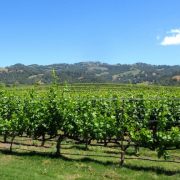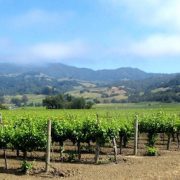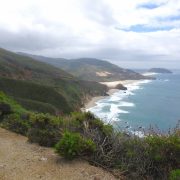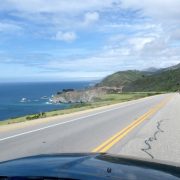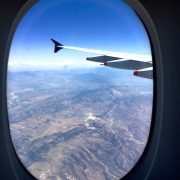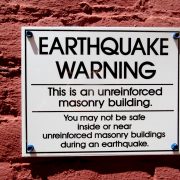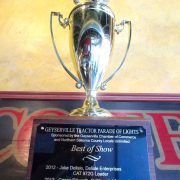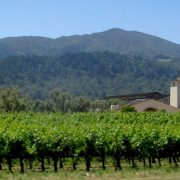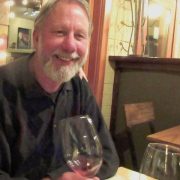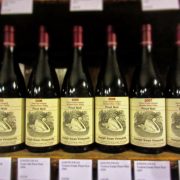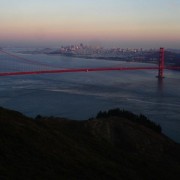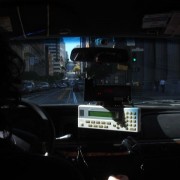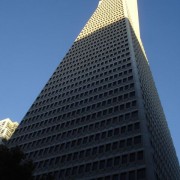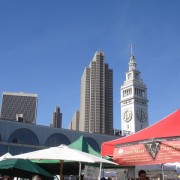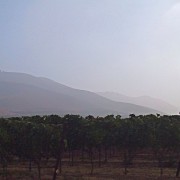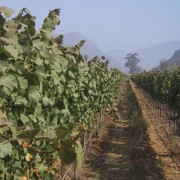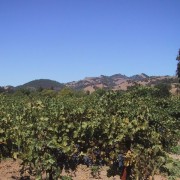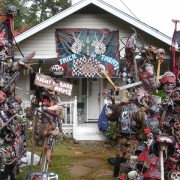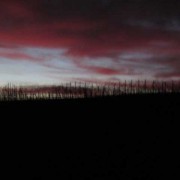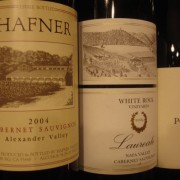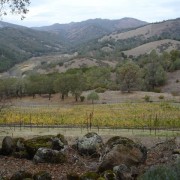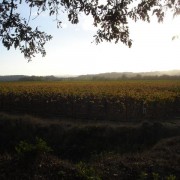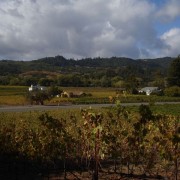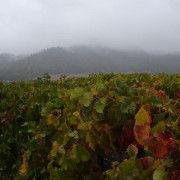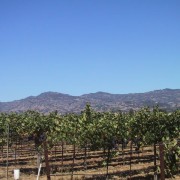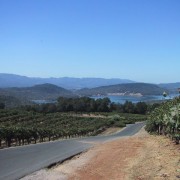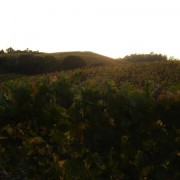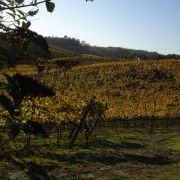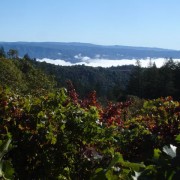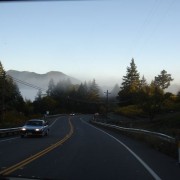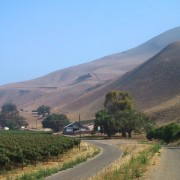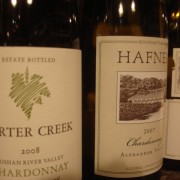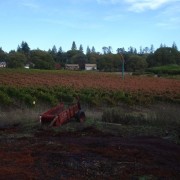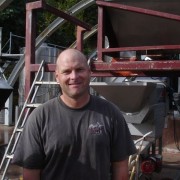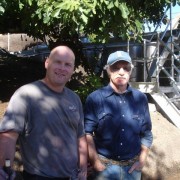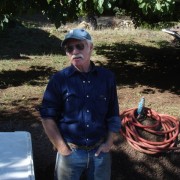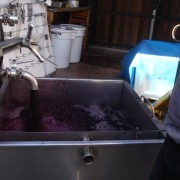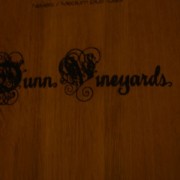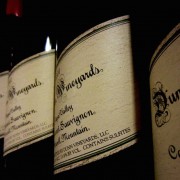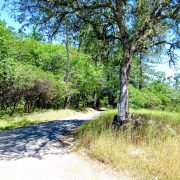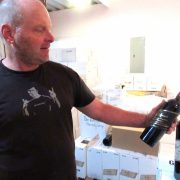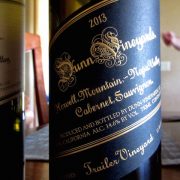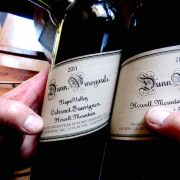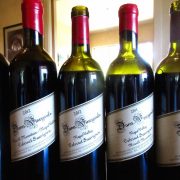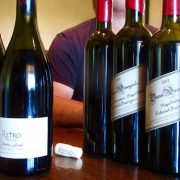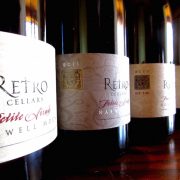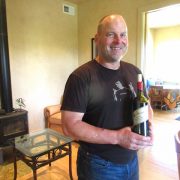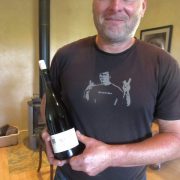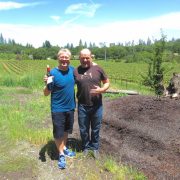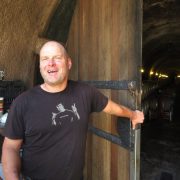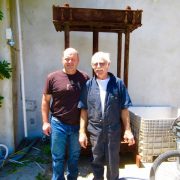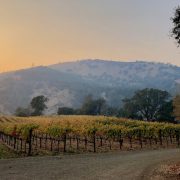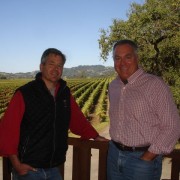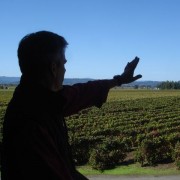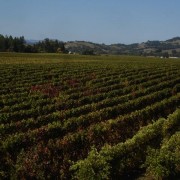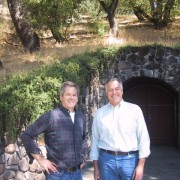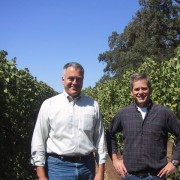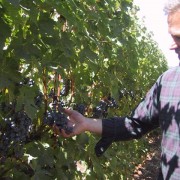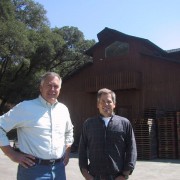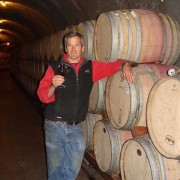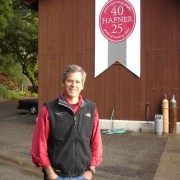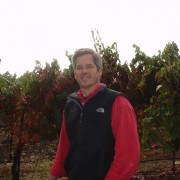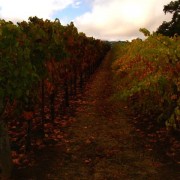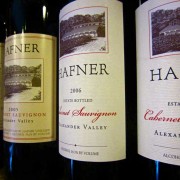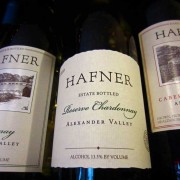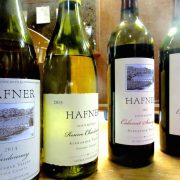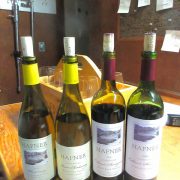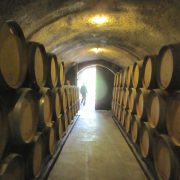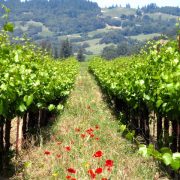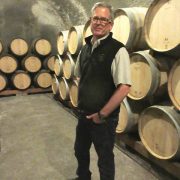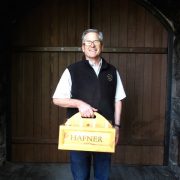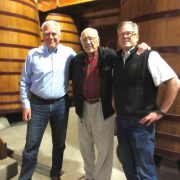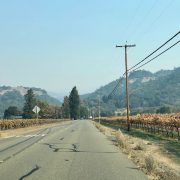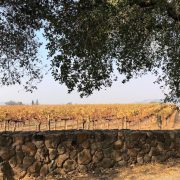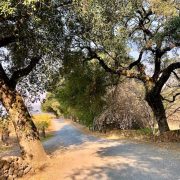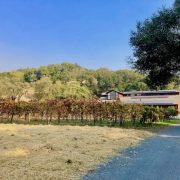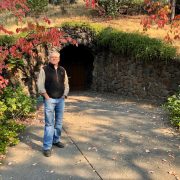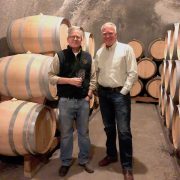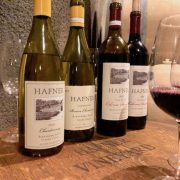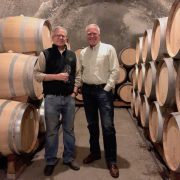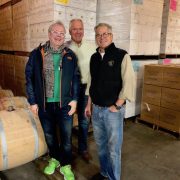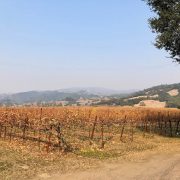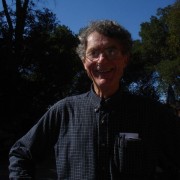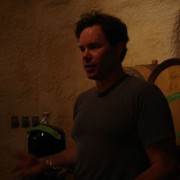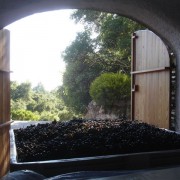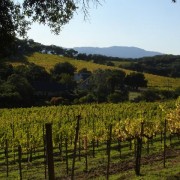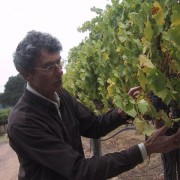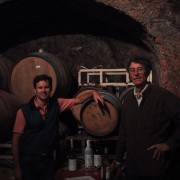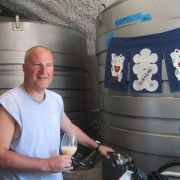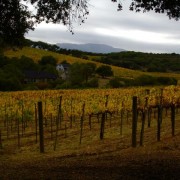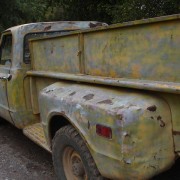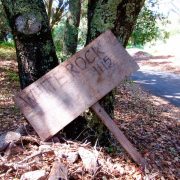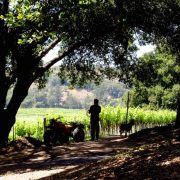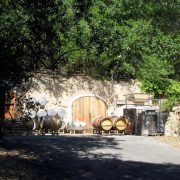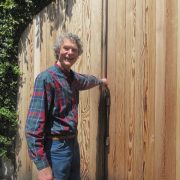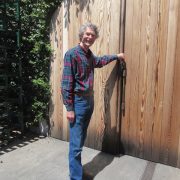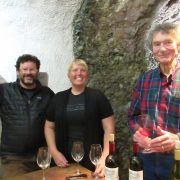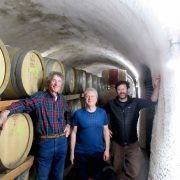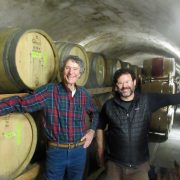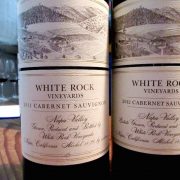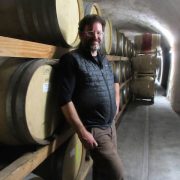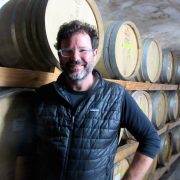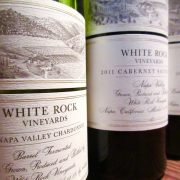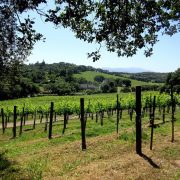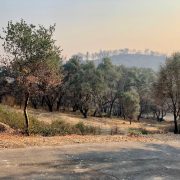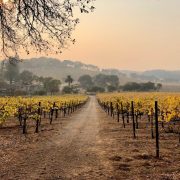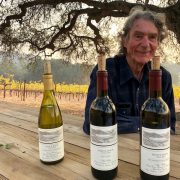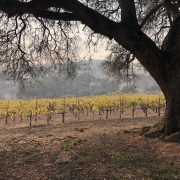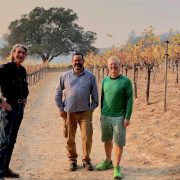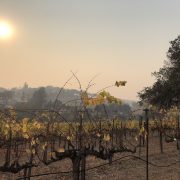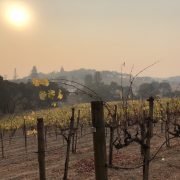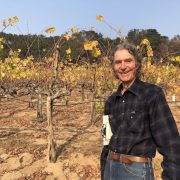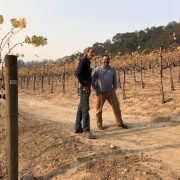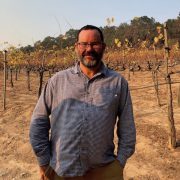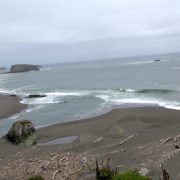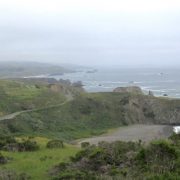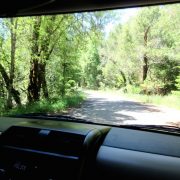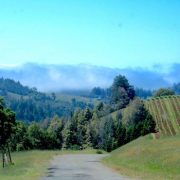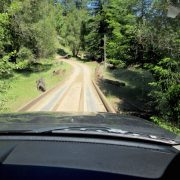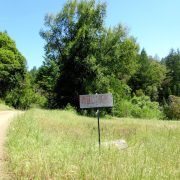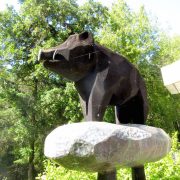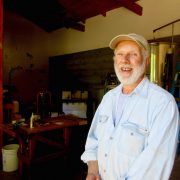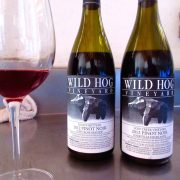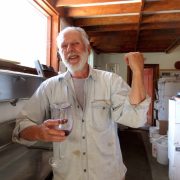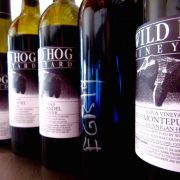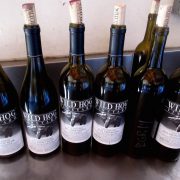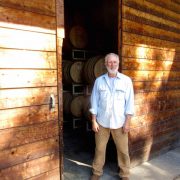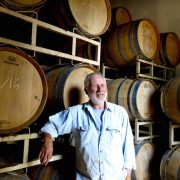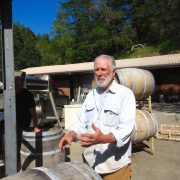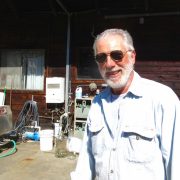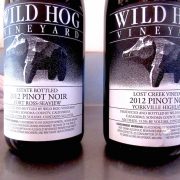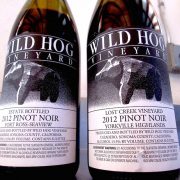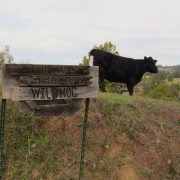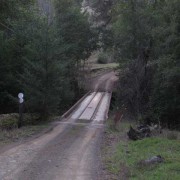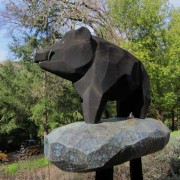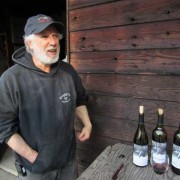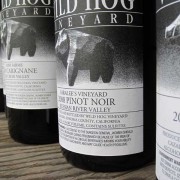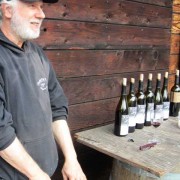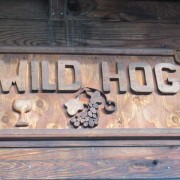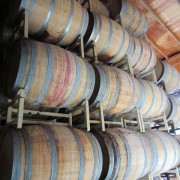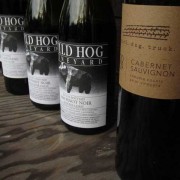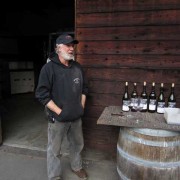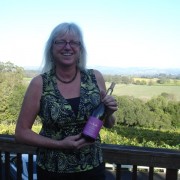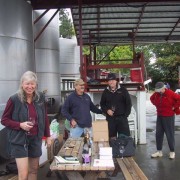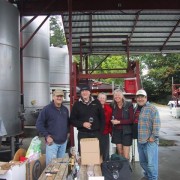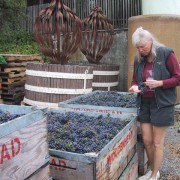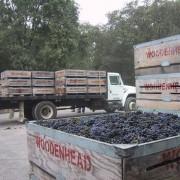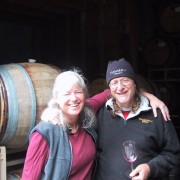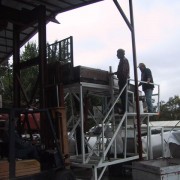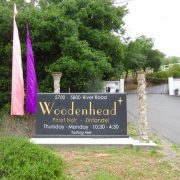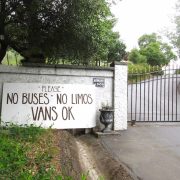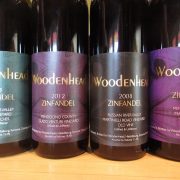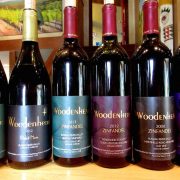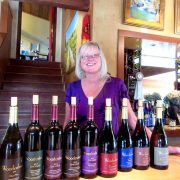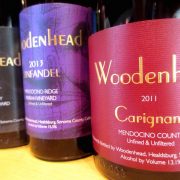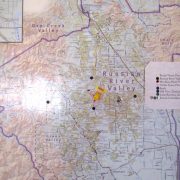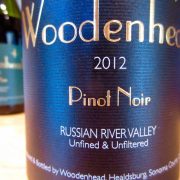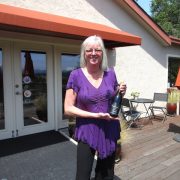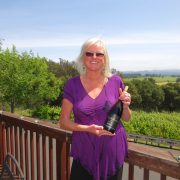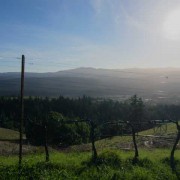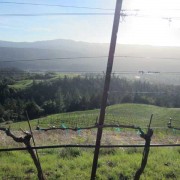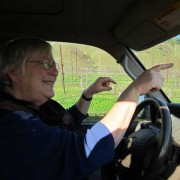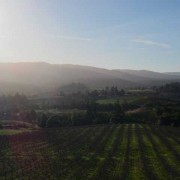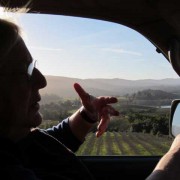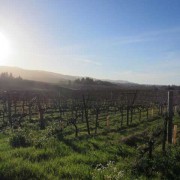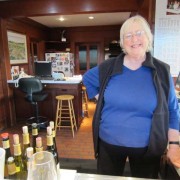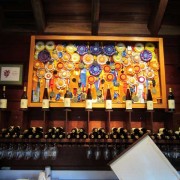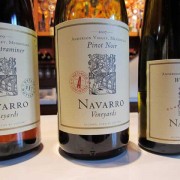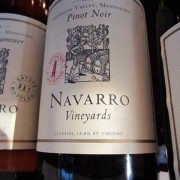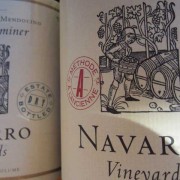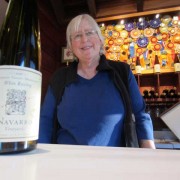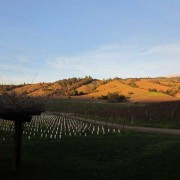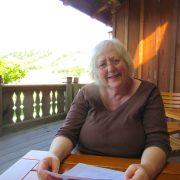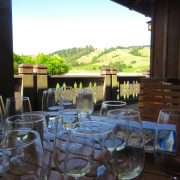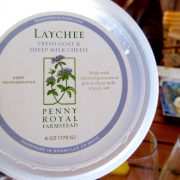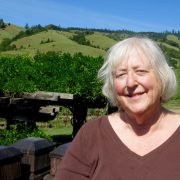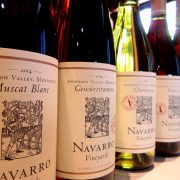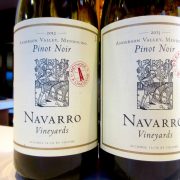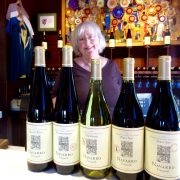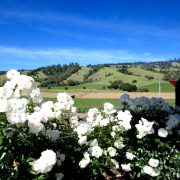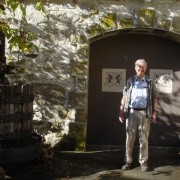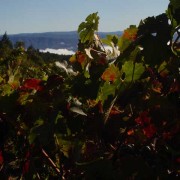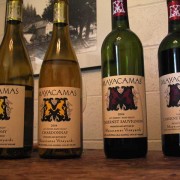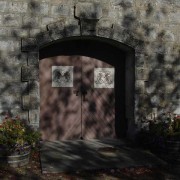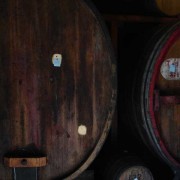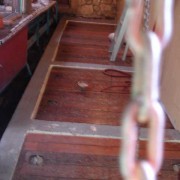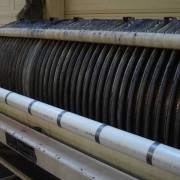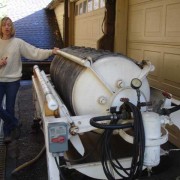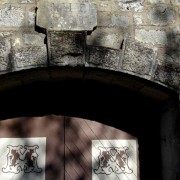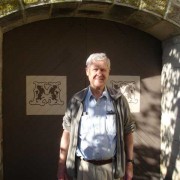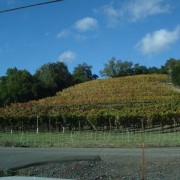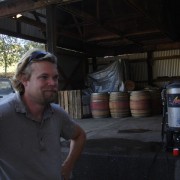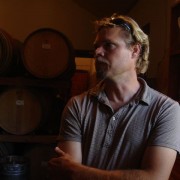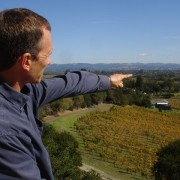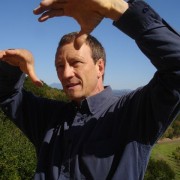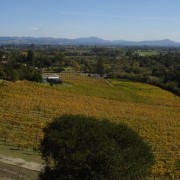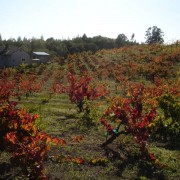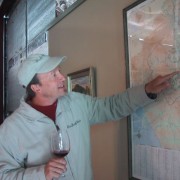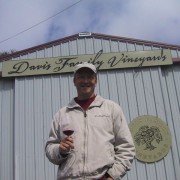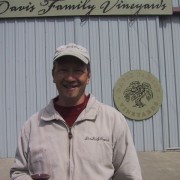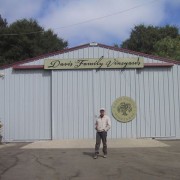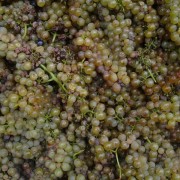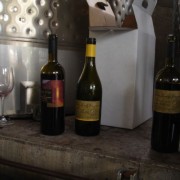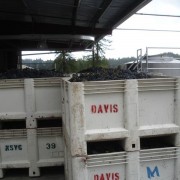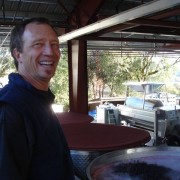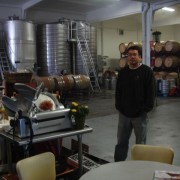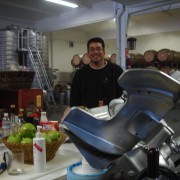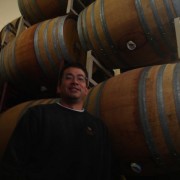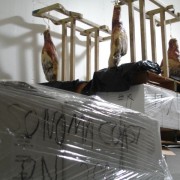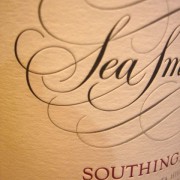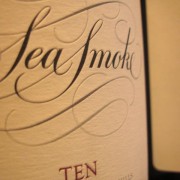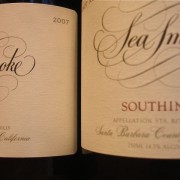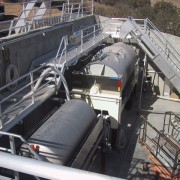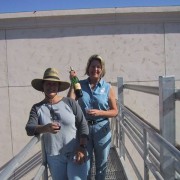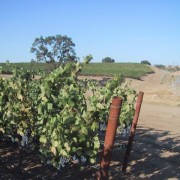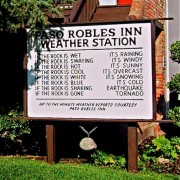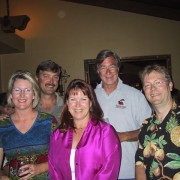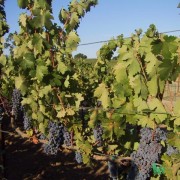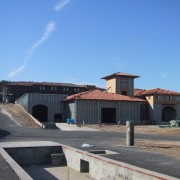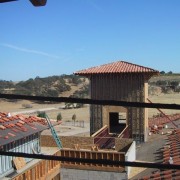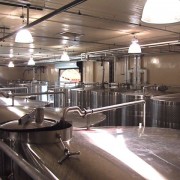Dunn (Howell Mountain/Napa)
One of the cult wineries of the 1970s. There is no sign on the driveway. Just a number on one of three mailboxes on Angwin Main St which is really just a road through a wood with the occasional timber house.
Randy Dunn had a PhD in Insects from UC Davis, dabbled in making wine, then went to work at Caymus in 1975. He and his wife Lori found a vineyard for sale up on Howell Mountain in 1978 which Caymus bought for them before deciding they didn’t want it after all. In 1979 the winery was established and they released their first wine in 1981. Randy’s energetic, enthusiastic, mountain bike mad son Mike also studied at UC Davis and now handles most of the work in the cellar.
They make two wines, Howell Mountain and Napa Valley. Both Cabernet Sauvignon, both made identically. The only difference is the fruit and the soil. “Our Howell Mountain fruit has very small berries and tons of skin. The soil is volcanic and it’s cooler at night up here. Down on the valley floor it’s more alluvial and there’s more water.”
In David’s opinion they make the finest Cabernet Sauvignon outside Bordeaux. Built for the long term, bottles from the mid-80s are at their peak.
Green and Red (Chiles Canyon/Napa) ORGANIC
Green & Red Vineyard, named for its red iron soils veined with green serpentine, is located in the steep hills on the east side of Napa Valley. Each time we visit, more of affable Jay Heminway’s past is revealed: he trained as a sculptor, studied in Italy as a sculptor, taught sculpture, had a gallery in San Francisco, became disenchanted, got divorced and bought a place in the Napa hills to get away from it all.
The guy who came to install his septic tank told him “you’ve got some great geology here – you should plant some vines”. It wasn’t long before Jay was off to Bordeaux to do a season at Chateau Lascombes followed by a spell with NYC wine merchants Sherry Lehmann and Alexis Lichine. He planted the vines in 1972 and started selling his wines in 1977. Now joined by his second wife he has never looked back and neither have we. Jay makes our favourite organic Zinfandels. Jay, normally very self-effacing, is proud of his high altitude vineyards, way above the fog line, up at 1,700ft, where the soils are red and rocky.
Hafner (Alexander Valley/Sonoma)
Scott and Parke Hafner have a different business model to most. They only sell to private clients, no retail. We were lucky to spot a bottle from the 5% they sell into restaurants in California. Scott and Parke Hafner’s family winery is beautifully located in Alexander Valley and surrounded by their own meticulously kept vines. While their winery was being built back in the early 80’s, Parke Hafner did a stint at Comte Lafon in Meursault, influencing the style ever since. Lush, ripe Alexander Valley fruit unobscured by oak, with aromas of roasted nuts and a stream of minerality rarely seen in Californian Chardonnay.
If their Chardonnay looks to Burgundy for its benchmark, their Cabernet looks to Bordeaux rather than Napa for its inspiration. Although Alexander Valley produces succulent fruit, the valley is cooler than Napa, making the wine more restrained than its neighbour from the other side of the canyon. We revel in the generosity and pure, high-toned fleshiness of their Cabernet, reminding us of those legendary Cali bottles from the 70s and 80s before some people got carried away with new oak and over-extraction.
Did we say no retail? There is one exception – we are proud to be the only shop in the world to have Hafner wines.
White Rock (Soda Canyon/Napa)
In 1977 Henry Vandendriesche revived the small White Rock winery which had been originally set up in 1870. It’s in a beautiful side valley below the Stags Leap outcrop off the Silverado Trail in the heart of cool-climate Napa Valley. Henry’s son Chris has been making the wine recently. Their amazing cellar, dug out of the white rock, a compacted layer of volcanic ash, has one section at the back which they rent out for “custom crush” – which basically means several of Chris’ mates make their own boutique wines there. Meanwhile, elsewhere in the cellar, Henry and Chris continue to make their beautifully-crafted Chardonnay and Bordeaux-style blends.
Wild Hog (Cazadero/Sonoma Coast)
Daniel Schoenfeld headed for the hills in the 1970s, looking for a simpler life. Finding him in the hills on the Sonoma Coast was tricky. When we first visited almost a decade ago, he faxed us the directions from the nearest (already remote) road taking us through forests and fording streams. On our most recent visit, he emailed the directions and it wasn’t any easier. Despite being around 10 miles as the crow flies from Jenner (population 136), it takes an hour to get to his hideout winery, including 40 minutes cross-country. Daniel and his wife Marion have transformed the rugged mountain property into a beautiful lush garden resplendent with vineyard, orchard, vegetable beds, and fragrant flowers. Having made some wine in demi-johns in his college dorm he had another go when they got to the woods. Friends then encouraged him to sell some…the rest is history. Over the years Daniel has experimented with a wide range of varietals, including small lots of Dolcetto, Nebbiolo, Barbera, Sangiovese and Montepulciano. He has recently been trimming the range to what he is best known for – distinctive organic Pinot Noir, Zinfandel and Petite Sirah. Why Wild Hog? Because the countryside is thick with wild hogs.
Woodenhead (Forestville/Sonoma)
The mystery is solved. On our second visit to Woodenhead we finally asked where the name Woodenhead comes from. “Nik’s ex-girlfriend thought he was very stubborn, so used to call him a “Wooden Head”, winemaker Nik Stez’s then current girlfriend and partner Zina Bower told us.
When we first stumbled across Woodenhead they had their handful of barrels in the corner of a bankrupt winery in Forestville. They were doing the crush with an enthusiastic bunch of friends including a fireman from San Francisco, and a local teacher who had called-in sick.
Construction worker Nik Stez got the wine bug by working a couple of harvests with the legendary Burt Williams at Williams Selyem, the original Pinot garage winery in the Russian River Valley. Nik and Zina buy small lots of fruit from several vineyards. Wiley is from Anderson Valley which has a strong coastal influence from the Pacific Ocean. Humboldt County is from Eel river where there are huge Redwoods. Martinelli Road belongs to one of the feuding Martinelli brothers. Tiny production, unfiltered, unfined, fragrant and supple. Muscular, even.
Wrath (Santa Lucia Highlands)
We stumbled across one of Wrath’s impressive Pinot Noirs as we overnighted in San Luis Obispo on our way from LA to San Francisco. Although based in the Santa Lucia Highlands 40 miles southeast of Monterey, they also have a very conveniently located tasting room in Carmel.
Wrath make a wide range in white and red (Chardonnay, Sauvignon Blanc, Falanghina, Syrah & Grenache), it is fair to say that their specialism is Pinot.
The clonal selections feature on some of their Pinot Noir labels. We fell in love with their elegant, stylish Swan/828. The Pommard 4/777 is a bit spicier with some more noticeable oak notes. The single vineyard selections from San Saba Vineyard and the Tondré Grapefield are richer, deeper and more lush.
Navarro (Philo/Mendocino)
A little piece of Alsace in Anderson Valley! Forty years ago in Berkeley, across the Bay from San Francisco, Ted Bennett met Deborah Cahn. Ted had a chain of Hi-Fi stores and Deborah was studying at the Niels Bohr Institute. Ted sold up and they joined the back to the land movement. They knew they wanted to make wine and were exploring possibilities. UC Davis had made a study which suggested the northern end of the Anderson Valley, close to the ocean, would suit dry Gewurztraminer. This was before Chardonnay became the dominant white varietal. Ted and Deborah bought a big plot of remote land between Philo and Navarro, north of Boonville and over the years have expanded their range to include Muscat, Pinot Gris, Riesling, Sauvignon Blanc, Chardonnay, Pinot Noir and the list goes on. The wines are fabulous. Beautifully made and full of cool climate character.
The fog comes in every night, clearing usually by 8 or 9 each morning. This means they have abundant, natural botrytis and are forced (if that’s the right word) to make some succulent dessert wines, some of the most renowned examples in the States.
Their “back to the land” dream has come true. Now entirely self-sufficient for food from their own land. Goats, sheep, wild birds, rabbits, cheese, eggs, chickens and so on. Their daughter Sarah has just started making goats’ cheese in Boonville, where they have a smaller ranch also with vines, called Pennyroyal Farm.
Mayacamas (Mount Veeder/Napa)
Mayacamas Cabernet is unique, it’s an enigma.
When you think of Californian Cab, descriptors like lush, ripe, fleshy, big, rich, powerful and (often) oaky come to mind. Not one of these applies to Mayacamas. It even makes Dunn, the other unreconstructed Cabernet in the valley, seem lush. And yet, if you’re looking for helpful parallels, you wouldn’t necessarily be looking at Bordeaux either, although Gruaud-Larose might be the closest – punishingly hard for its first twenty years (and here’s where the similarity ends) before emerging as a slightly softer, friendlier adult.
Mayacamas is tough, austere, without any sense of fruit or flesh. It’s unfruity. It’s strict. It has a haunting beauty, one you have to search for and learn, like your first taste of coffee or olives. It’s its own thing. If you had to pin down a fruit component, you might describe the freshness you find in strawberries rather than the sense of the fruit itself. Freshness courses through it like a trapped waterfall. Whether ten or twenty years old it still seems young. Two decades will not tame it, it has drunk from the Fountain of Youth. It’s the Anti-Cab!
The original winery was founded in 1889 in a dormant volcanic crater, high on Mount Veeder on the west side of Napa Valley, by John Henry Fisher, a German sword engraver and pickle merchant. The 1906 earthquake bankrupted him and his pickle business and, from that point on, the winery changed hands every couple of years. During Prohibition bootleg wine and grappa was made in the remote hill cellar. In 1941 it was bought by Jack Taylor, a Brit married to a Californian, who gave it an Indian name, Mayacamas, meaning either “water out of the mountain” or “howl of the mountain lion”. The Taylors retired in 1968. Enter Robert (Bob) Travers who had also retired albeit at the princely age of 30 having made a sackful in the finance business in San Francisco. At that time there were only 25 wineries in Napa Valley. Bob was introduced to the legendary Joe Heitz and apprenticed with him for a year. Bob has been making his own wine the same way ever since, achieving cult status in 1976 as part of the Judgement of Paris Tasting. It’s such a pleasure to taste unreconstructed, unmessed-with, pure Cali Cab – the way it was in the 70s before the fashion shifted to more fruit, more oak, more everything.
Mayacamas – unfruity beauty. Time capsule. The second coming of the Anti-Cab.
Porter Creek (Russian River Valley/Sonoma) ORGANIC
Organic winery on Westside Road in the Russian River Valley, not far from Healdsburg. After internships in California, Burgundy and the Rhone (Sonoma-Cutrer, Bernard Michelot, Christophe Roumier, Camille Giroud and Guigal), 40-year-old Alex Davis took over from his father, George, in 1997. “It was Roumier who taught me that the grapes will tell you how hot they want to go.”
“Zinfandel is a big-berried grape. It’s not supposed to be noble, it’s a goofy thing.” He does a very gentle pressing in his old bladder press, adds 10% Carignan and “then I give the rest to the compost gods.”
“Although I don’t like the stereotypical oaked Cali wines, I do like the exchange with old oak.”
He picks at 4 in the morning and, apart from a little sulphur, adds nothing. All wild yeasts.
Davis Family (Healdsburg/Sonoma)
Guy Davis gives the impression of the archetypical Californian winemaker – a wonderful combination of laid back and infectiously enthusiastic. His winery is on the outskirts of Healdsburg overlooking the Russian River which, most of the time, is less of a majestic river and more of a trickle. Russian River Valley is widely held to be one of the best spots for Chardonnay and Pinot in California and every year he swiftly sells out of his Dutton Ranch Chardonnay and his ferny, autumnal, raspberry toned Pinot.
“Over the years I’ve been jockeying for position in the Dutton Vineyard, which is divided into very spread-out parcels. I now get the fruit from the far west side, near Occidental and it’s way cooler there.”
When we visited last autumn, he took us to his house, complete with 100 year-old Zin vines and a beautiful view eastwards over the valley. “There was no way my wife and I could have afforded this house, but it was used by a bunch of wasters as a Crystal Meth Lab, the Cops came and the bank foreclosed. It was in such a bad state we got it for a steal!” Far out!
Anthill Farms (Healdsburg/Sonoma)
Mega-scarce, mega-tiny, mega-boutique, mega-Pinots. Oh, and a bit of Syrah. Three young guys, Anthony Filiberti, Webster Marquez and David Low met at Williams-Selyem and decided to make wine together. They have a handful of barrels in the corner of Papapietro Winery just outside Healdsburg on the road up to Dry Creek. Pure, ethereal and with a blessed lightness of touch with the oak, these are state-of-the-art un-showy Pinots for Pinot lovers.
Sea Smoke (Santa Rita Hills/Santa Barbara County)
It’s a very different expression of Pinot Noir here in the Santa Rita Hills at the western end of Santa Barbara County on the Central Coast. The sea fog, or marine layer, rolls in along the canyon and keeps it cool enough to make Pinot possible this far south. Video Games CEO and Burgundy nut Bob Davids wanted to make his own Pinot Noir (and a little Chardonnay) and had his heart set on a south-facing strip in the canyon overlooking the Santa Ynez River. The bean farming owner didn’t want to sell but, after a long and concerted campaign, was made an offer he couldn’t turn down. So in 1999, with winemaker Victor Gallegos onboard, Sea Smoke was born. They produce four wines; a tiny amount of Chardonnay and three Pinots. The Southing, Ten (which is made from their best ten barrels) and One (which is their single best barrel).
Rabbit Ridge (Paso Robles/Central Coast)
Erich Russell was such a fast runner at college, they called him “the Rabbit”. It was natural to call his winery Rabbit Ridge and scan his lucky jeans for the blue label. In the early 2000s they moved from cool-climate Healdsburg in Sonoma into a brand new winery in baking-hot Paso Robles in Central California.
We visited the new winery outside Paso Robles at the beginning of the 2003 harvest. It was still very much a building site, the fermentation tanks had only been delivered a few days earlier and were being connected as the first crush arrived! Erich and his wife Joanne James are crazy about things Italian, so the new facility is a rhapsody on an Italian theme – a palazzo on the desert’s edge. Many of you have already tasted his Barbera, the Super-Tuscan “Montepiano” and his Sangiovese (in our opinion, the best version of the Chianti varietal to come out of California). Although Rabbit Ridge has expanded rapidly over the past five years, it is still very much a family concern – both Joanne’s sisters are now on board and Erich’s brother-in-law is now helping with the winemaking. The Paso Robles palazzo is surrounded by vines, part of Erich’s masterplan to increasingly rely on his own fruit and to experiment more with lesser-known varietals such as Primitivo and Carignan. Olive oil is also part of the plan.
